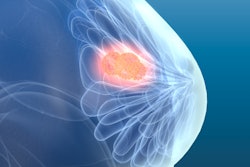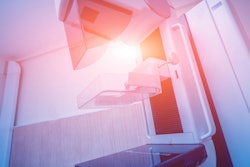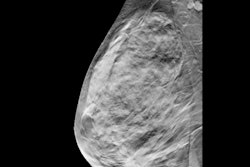
The use of a low-dose tomosynthesis protocol for screening women with breast implants allows a significant reduction in radiation exposure while maintaining adequate image quality and maximizing the diagnostic performance, Italian researchers have found.
"Due to the typical radiopacity of implants, tomosynthesis is not currently the technique of choice for screening this type of breast," noted Dr. Enrico Pofi, director of the UOC di Radiologia Ospedale S. Filippo Neri, and his colleagues in Rome. "Guidelines in Italy, the U.K., and the U.S. agree that 2D mammography, in the presence of a breast implant, does not offer a reliable diagnosis and therefore invite clinicians to perform the Eklund maneuver."
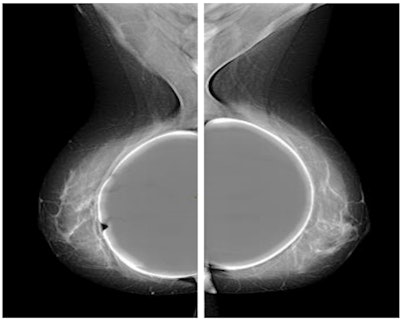 Mediolateral oblique (MLO) view full-field digital mammography of patient with breast implants using the exposure control algorithm. All figures courtesy of Roberta Fedele, Enrico Pofi, et al and presented at EuroSafe 2023.
Mediolateral oblique (MLO) view full-field digital mammography of patient with breast implants using the exposure control algorithm. All figures courtesy of Roberta Fedele, Enrico Pofi, et al and presented at EuroSafe 2023.The researchers therefore decided to investigate the use of a protocol in which tomosynthesis can provide more diagnostic information, even in the presence of breast implants, reconciling the technical, methodological, and dosimetric aspects.
They prospectively enrolled 53 women (age range, 50-74; average age, 65) who joined the breast screening program in the ASL Roma 1 regional health system.
The women were divided into two groups. The first group included 15 women undergoing standard protocol with standard configuration for the automatic exposure control (AEC) algorithm present on the mammography unit, including eight projections: four with digital mammography that included the breast implant and four with tomosynthesis (with synthetic image) using the Eklund maneuver, a modified compression technique that can be used for patients with augmented or reconstructed breasts postmastectomy.
In a second group of 38 women, a low-dose configuration of the AEC was activated to ensure a low-dose protocol.
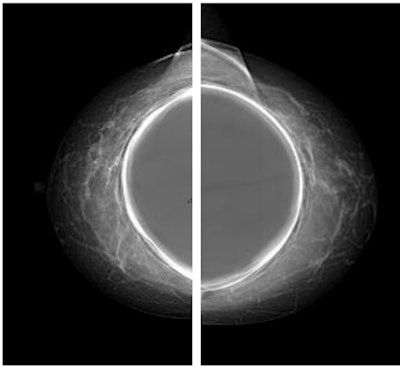 Craniocaudal (CC) view full-field digital mammography of patient with breast implants using the exposure control algorithm.
Craniocaudal (CC) view full-field digital mammography of patient with breast implants using the exposure control algorithm."In our patient cohort, we demonstrated that with the study in mammography mode and only four projections with prosthesis included, and using a standard exposure meter, the exam is associated with an average glandular dose of 7.5 mGy," the authors stated.
If the Eklund maneuver is also performed in tomosynthesis mode, the woman is exposed to an average of 11 mGy in total. A low-dose configuration of the AEC is associated instead with an average glandular dose equal to 9.2 mGy total. This configuration allowed a maximum amount of radiographic information currently possible, lowering the dose by 15%, while maintaining adequate image quality, they pointed out.
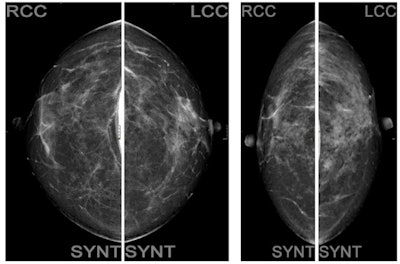 Standard algorithm versus low-dose algorithm in tomosynthesis.
Standard algorithm versus low-dose algorithm in tomosynthesis.AEC is incorporated into radiographic and mammographic imaging systems. Its function automatically terminates exposure when a preset amount of radiation has been detected. Automatic exposure control systems help to provide a consistent optical density/signal-to-noise ratio between images, regardless of patient-centric factors such as size and density. They also help to reduce "dose creep" that can occur with inadvertent radiation overexposure by the radiographer.
"At the present time, tomosynthesis for the study of breasts with implants is not considered a valid diagnostic test, mainly due to the encumbrance of the prosthesis. However, the results of this test seem to highlight the possibility to use it effectively," the authors concluded.
For further technical details about the low-dose protocol, go to the EPOS section of the ESR website (first author Roberta Fedele). The co-authors of the study were Enrico Pofi, Rosella Stella, Domenica D'Ottavio, Pasquala Ragucci, Stella Pedilarco, and Ilaria Valenti.




